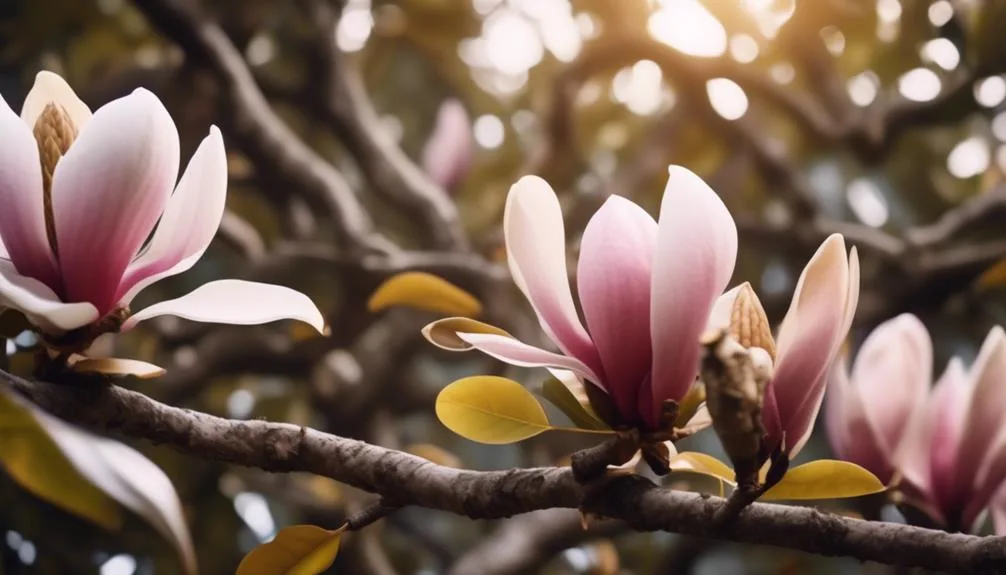Wondering how to tell the difference between different magnolia tree species? Each type has its own unique characteristics, from leaf shape to flower color and size.
By learning these key features, you can develop a deeper appreciation for these beautiful trees and understand what makes them distinct.
Leaf Characteristics
When identifying magnolia tree species, examine the leaf characteristics, including size, shape, and color, to distinguish between different varieties. Start by observing the leaf shape, as it varies among magnolia species. Some magnolia leaves are oval or oblong, while others are more linear or lanceolate.
Additionally, pay close attention to the leaf coloration. Magnolia leaves can range from dark green to a lighter, almost silver-green color. Some species even have a velvety, coppery underside to their leaves.
These distinct leaf traits are crucial in identifying different magnolia tree species. By carefully noting the leaf shape and coloration, you can begin to differentiate between the various types of magnolia trees and appreciate the unique beauty each one offers.
Flower Features
To further distinguish between different magnolia tree species, closely examine the distinctive flower features, which play a significant role in their identification and appreciation. When identifying magnolia trees, consider the following:
- Pollination Process and Floral Scent
- Magnolia flowers often rely on beetles for pollination, and their unique floral scent varies among species, ranging from citrusy to sweet and spicy aromas.
- Color Variations and Bloom Time
- Magnolia flowers exhibit a wide range of colors, including white, pink, purple, and yellow, with some species even featuring multiple hues within a single bloom. Additionally, bloom times differ among species, with some flowering in early spring and others in late spring or summer.
Bark and Stem Traits
Examine the bark and stem traits of magnolia trees to identify unique characteristics that distinguish different species. Bark texture and stem color are key features to observe. The bark of magnolia trees can range from smooth to rough, and from gray to brown, depending on the species.
During winter, when the flowers and leaves are absent, the bark and stem traits become even more important for identification. Some species have distinctive patterns or colors on their bark, which can aid in differentiation.
When pruning magnolia trees, it's essential to take note of the bark and stem traits to ensure the health and vitality of the tree. By paying attention to these details, you can better understand and distinguish the various magnolia tree species.
Growth Habit and Size
What distinguishes the growth habit and size of magnolia trees, and how can these characteristics aid in species identification?
Magnolia trees exhibit a variety of growth habits and sizes, which can help in identifying different species. Understanding these traits can also assist in ensuring proper care and maintenance of the trees.
When identifying magnolia tree species based on growth habit and size, consider the following:
- Growth Habit:
- *Upright*: Some species grow in a tall, upright manner.
- *Low-spreading*: Others have a low-spreading growth habit, making them ideal for ground cover.
- Size:
- *Small to medium*: Magnolia trees can range from small to medium in size, making them suitable for different garden landscapes.
Understanding these growth habits and sizes can aid in selecting appropriate pruning techniques and soil requirements for each specific magnolia tree species.
Geographic Distribution
The geographic distribution of magnolia tree species varies widely across different regions, influencing their adaptability to specific climates and environments. Magnolia trees are primarily found in temperate regions of Asia, the Americas, and parts of Africa.
They thrive in a variety of climates, from subtropical to temperate, depending on the species. Some magnolias, such as the Southern magnolia, prefer warm, humid climates, while others, like the star magnolia, are more adaptable to cooler temperatures.
When it comes to soil requirements, magnolias generally prefer moist, well-drained, slightly acidic soils, but they can also tolerate a range of soil types. Understanding the specific climate preferences and soil requirements of different magnolia species is crucial for successfully cultivating these beautiful trees in various geographic locations.
Conclusion
Now equipped with the knowledge to differentiate magnolia tree species, keep an observant eye out for their unique leaf, flower, bark, and growth characteristics.
By recognizing these distinct features, you can confidently identify various magnolia trees in your area.
Happy tree spotting!

My interest in trees started when I first saw the giant sequoias in Yosemite.
I was a teenager then, and I remember thinking, “I need to learn more about this.”
That moment stuck with me.
A few years later, I went on to study forestry at Michigan Tech.
Since graduating, I’ve worked in a mix of hands-on tree care and community education.
I’ve spent over ten years helping people understand how to plant, maintain, and protect the trees in their neighborhoods.
I don’t see trees as just part of the landscape.
They are living things that make a real difference in our daily lives.
